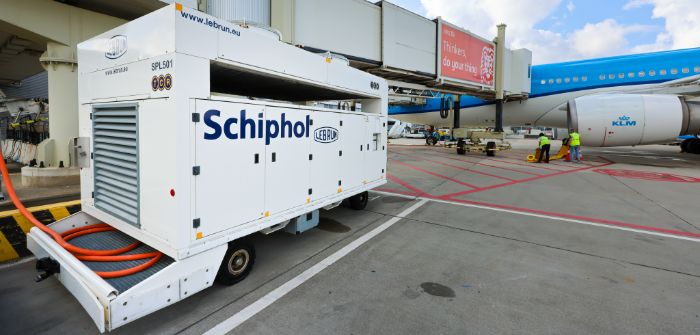Schiphol airport in the Netherlands is replacing its fuel generators with 30 electric ground power units (e-GPUs) and is introducing more electric pre-conditioned air systems (PCAs) that provide fresh air on board parked planes.
The new e-GPUs will be used around the aircraft stands on Pier C and on those on the inside of Pier D. The first 13 e-GPUs are being installed in August and all 30 will be in service by the autumn. Combined with the fixed power points offered at various piers, aircraft at the gate will be provided with emission-free power throughout Schiphol, which runs entirely on Dutch wind power.
An e-GPU powers aircraft on the ground, which is needed for onboard systems such as lighting and cockpit computers when the engines and auxiliary engines are switched off. The power bank consists of multiple batteries powerful enough for narrow-body aircraft. Schiphol had already designed and successfully tested the mobile e-GPUs in cooperation with ITW GSE and Nissan, with eight already in use before the arrival of these further units.
By increasing the use of electrical devices that provide aircraft with fresh air, 50% of the larger types of aircraft will be able to leave the auxiliary engine off at the gate. This improvement is part of the action plan Schiphol presented to the Human Environment and Transport Inspectorate to limit the use of auxiliary engines. Schiphol considers this a priority because it brings tangible improvements in working conditions and the health of apron employees.
Aircraft parked at various piers at Schiphol will now get their power from emission-free equipment thanks to the arrival of these new e-GPUs and the electric PCAs at piers E, F and G ensure that parked planes receive fresh air. These replacements are part of the airport’s steps toward emission-free ground handling by 2030.
At the moment, 40% of ground-handing equipment at Schiphol is electric. Replacing fuel power units and keeping auxiliary engines switched off helps the airport achieve the Labour Inspectorate’s requirements to improve air quality.
Denise Pronk, responsible for sustainability at Royal Schiphol Group, said, “With the arrival of these e-GPUs and additional electric PCAs, the aircraft’s auxiliary engine can remain switched off more often. That’s good for a variety of reasons. Thanks to these investments, CO2 emissions will decrease and the air quality on the apron, and thus the working conditions for staff, will improve. We are pleased that, together with KLM, dnata and Aviapartner, we have been able to create a pool where all employees on the apron can use available equipment.”
Jorben Sprong, unit manager of operational support apron services at KLM Ground Services, said, “The 30 new e-GPUs are another great step toward equipping the entire apron at Schiphol with electric ground equipment in the future. By pooling these e-GPUs, we can make optimal use of the ground equipment and emissions are significantly reduced. We are working together with the sector to introduce more e-GPUs at Schiphol as quickly as possible and to find a solution for wide-body planes, for which the e-GPU cannot yet be used.”
Paul Feldbrugge, manager of fleet management and engineering at KLM Equipment Services, said, “The introduction of 30 new e-GPUs is aligned with KLM Equipment Services’ strategy as pool manager and GPU owner to electrify the entire GPU pool by 2030. This process is running parallel to the installation of charging facilities at the airport that are critical for the use of e-GPUs.”
For more key sustainability updates from the passenger terminal industry, click here.


